Table of contents
- New noise regulation for motorcycles from 2016 Sound or impertinence?
- Noisy motorcycles are on the rise
- Motor management recognizes test cycle area
- New test procedure closes legal loopholes
- Accessory exhaust systems are a chapter of their own
- Comment from test manager Gert Thole
- KTM and Akrapovic are the quietest
- Interview with Holger Siegel from the federal government
Motorcycle noise
Debate about the volume of motorcycles
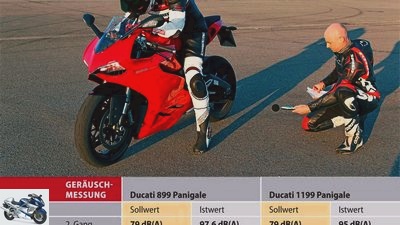
Photo: fact


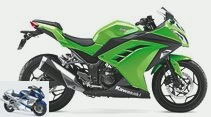
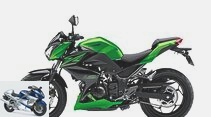
8th pictures
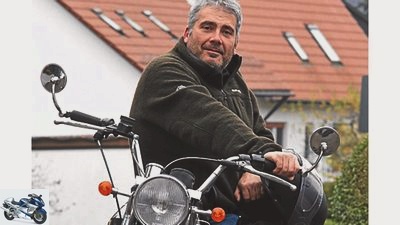
Chaqune
1/8
Moto Guzzi driver Holger Siegel is the spokesman for the motorcycle noise working group in the BUND.
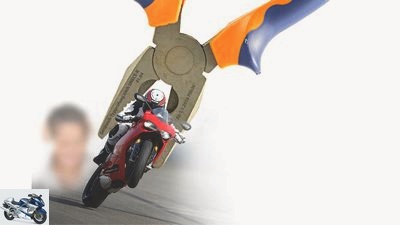
Fotolia / Ducati
2/8
From January 1, 2016, new noise regulations for motorcycles will apply. Some existing loopholes in the law will then be closed. The maximum sound level is then limited to 73 to 77 db (A).
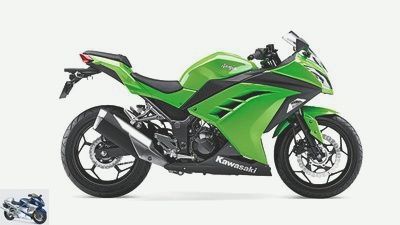
Kawasaki
3/8
Kawasaki already voluntarily has new models type-tested according to UNECE-R 41.01. Motorcycles do not necessarily perform worse, as the examples Ninja and Z 300 show: the engine, exhaust and intake tract are the same, and the driving noise is even lower in the new measurement cycle. Kawasaki Ninja 300 according to the old EU directive 97/24 / EG: 78 dB (A).
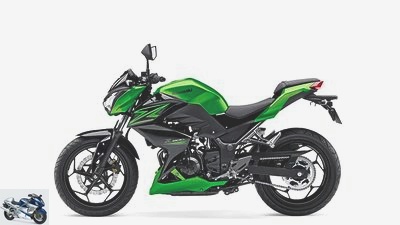
Kawasaki
4/8
Kawasaki Z 300 according to the new UNECE-R 41.04: 72 dB (A).
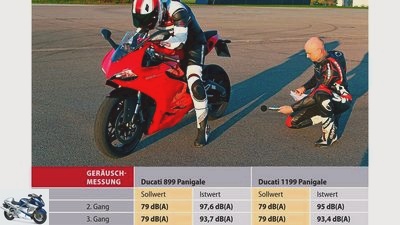
fact
5/8
What is too much is too much: Already during the first tests of the Ducati 1199 Panigale, it was noticed that at constant speed of around 50 km / h, thanks to the exhaust flaps, it switches from roaring loud to dull gasping. As part of a larger exhaust test, MOTORRAD carried out a driving noise measurement with the Panigale models 1199 and 899 (see table).
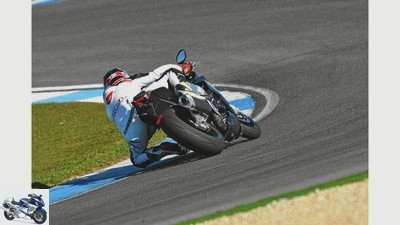
Soldano
6/8
A brisk lap during race training? On certain routes, limit values apply, at which loud series machines quickly fail.
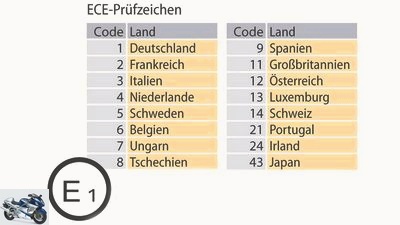
7/8
The number shows in which country the vehicle or component was type-approved. However, the technical examination may have been carried out in another country.
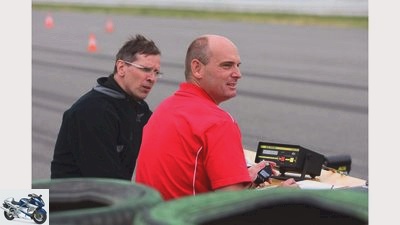
Bilski
8/8
Gert Thole (left), MOTORRAD test chief, enjoys the sound of well-sounding engines, but does not want to burden his fellow human beings with noise and noise.
counselor
traffic & business
New noise regulation for motorcycles from 2016
New noise regulation for motorcycles from 2016
Sound or impertinence?
The debate about the noise pollution caused by some motorcycles is intensifying. New noise regulations that will take effect at the beginning of 2016 will make trickery more difficult in the future and could ensure peace and quiet.
Brigitte Haschek
09/24/2015
The Winkler * family lives where others like to ride a motorcycle – in a tranquil village with 650 residents in the middle of the Thuringian Forest. As soon as the season opens and the weather is good, the retired couple sometimes lose their desire to drink coffee on the balcony in the sun and eat a piece of sour cream cake. What meanders through the small community as Suhler Strabe in front of your house is part of the L 1128, which leads curvy to the popular excursion destination Oberhof. “Although the speed limit here is 50, the noise from many machines often disrupts entertainment”, says Werner Winkler. Even the motorcycle enthusiast son-in-law stinks when he is visiting with his wife and children. Relax with grandma and grandpa in idyllic surroundings and heavenly peace? Puff cake!
Buy complete article

New noise regulation for motorcycles from 2016
Sound or impertinence?
4 pages) as PDF
€ 2.00
Buy now
All over the country, citizens go to the barricades because the other’s joy is their sorrow: the roar of the engines. The residents of Simmerath in the Eifel are also reacting increasingly annoyed to noisy two-wheelers. Some are even considering selling their property. Simmerath’s mayor, Karl-Heinz Hermanns, is in a quandary. He has to take the citizen protests seriously, but does not want to scare off the two-wheeled tourists. “We want to remain a worthwhile point of contact for motorcyclists”, says Hermanns. The Sauerland region, which, like the Eifel, offers many winding roads through the wild and romantic landscape, groans at those bikers who are looking for a technical challenge at the highest speed instead of a leisurely ride.
In response to complaints from residents, the Sauerland communities Meschede, Schmallenberg, Arnsberg and Sundern, together with the Hochsauerlandkreis and the police, have the “Regulatory partnership motorcycle noise” founded. “The speeders are clearly in the minority, but damage everyone’s reputation”, says Bianca Scheer from the police in Meschede.
Noisy motorcycles are on the rise
“Driving style is crucial”, also confirms Christian Popp, managing director of the Hamburg engineering office Larmkontor. “It can make a difference of 20 decibels whether someone drives irresponsibly or sensibly.” Of course, there are also louder and quieter motorcycles. But the loud ones are on the rise, as recent experience from the MOTORRAD editorial team shows. Harley-Davidson and Italian brands are traditionally not considered quiet, although the noisy Harleys are often pepped up with a retrofit silencer. Even BMW is now in for a riot: the touring K 1600 has the acoustic appearance of a super sports car, and the BMW bestseller GS also makes a lot of noise for a classic travel enduro. How does it work if the driving noise according to EU Directive 97/24 / EC may not exceed 80 dB (A)?
Motor management recognizes test cycle area
Max Hohler, expert for motorcycle components at TuV Sud in Munich, gives the reason: “The noise measurement process for homologation has so far been quite simple.” This allows manufacturers to design the engine management system in such a way that it recognizes the test cycle area and then immediately regulates the sound down using exhaust flaps or throttle control. Outside of the homologation-relevant driving conditions, he can then increase to fortissimo again. “This is common practice and completely legal”, says the TuV expert. Everyone in the industry does that – the Japanese tend to be moderate, some Italians, on the other hand, extreme.
New test procedure closes legal loopholes
Such trickery will finally be put to a stop on January 1, 2016 with UNECE-R 41.04. The standard has been in force since January 1, 2014, but will be mandatory for the from the beginning of next year “Conditions for the approval of motorcycles with regard to their noise generation”, as it is called in the best bureaucratic German. Depending on the power-to-mass ratio of the machine, the maximum sound level is limited to 73 to 77 dB (A) – in different driving conditions. “The completely new test procedure now closes the existing legal loopholes”, says Philip Puls, head of the technical service at TuV Sud in Munich. This is a specification of environmental protection. “Test cycle detection via the engine control and exhaust flap controls are expressly prohibited.” Danger recognized, but not averted. The UNECE rules of the game only apply to newly type-tested vehicles. There is so-called inventory protection for established models – and also for retrofit silencers that are already on the market. The only thing that helps here is the driver’s insight to reduce the noise.
Accessory exhaust systems are a chapter of their own
Exhaust systems from the spare parts shelf are another chapter of their own. Like motorcycles, they must be type-approved and comply with the driving noise limits. The operating license can be applied for in all EU countries and is then valid in all EU countries without further testing. The new regulation according to UNECE-R 41.04 theoretically also applies to accessory exhaust systems – but in the specific UNECE 92.01, which will not become mandatory until 2020. There is a wide range of retrofitting options for silencers. A large number of models are available with flap systems that can be adjusted mechanically in a few simple steps or electronically at the push of a button. In addition, damping inserts – so-called dB-Eater or dB-Killer – can usually be easily removed.
To make matters worse: Regular product tests by the MOTORRAD editorial team show that these retrofit systems often have higher driving noise levels than permitted. Such silencers have mostly received their type approval in other European countries. How is that possible when the noise limits apply in all countries? TuV man Philip Puls speaks of “Leeway for interpretation” the respective approval authorities. Other industry experts suspect that the prescribed production controls (COP = Conformity of Production) are sloppy. Munich TuV expert Max Hohler says: “The European approval authorities have different qualities – as do the technical services that inspect the systems.” Not all national institutions are as conscientious as the German KBA before they issue a type approval. Once the stamp is on, it can no longer be traced how, in which condition and for which models and variants a silencer got its stamp.
Comment from test manager Gert Thole
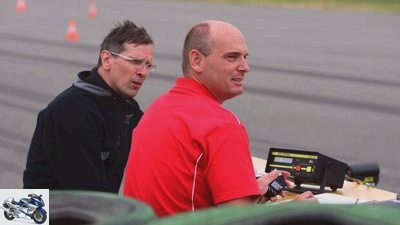
Bilski
Gert Thole (left), MOTORRAD test chief, enjoys the sound of well-sounding engines, but does not want to burden his fellow human beings with noise and noise.
Everyone – almost everyone – motorcyclist wants sound. When clogged engines hiss and rattle from dry damper tubes, then something is simply missing while driving. We want to feel, feel – and hear our machines. That’s one side of the medal.
The environment doesn’t want noise, people want peace and quiet, and for understandable reasons they react very sensitively to annoyance. Noise is pollution, noise makes you sick. In a society that is growing ever closer together, more than ever. That’s the other side of the coin.
KTM and Akrapovic are the quietest
Where is there scope for solutions? Ultimately only in a compromise, because consideration and tolerance are required on both sides. Perhaps many a local resident could react a little more calmly if their personal enemy image is confirmed once again by individual rowdy brothers. But that is not the crux of the problem. Rather, it is up to us, i.e. with those who produce the noise. We motorcyclists have to recognize limits. Cleared accessory dampers, removed db-eaters, even the standard flap controls: a no-go today. And do you have to cheer the 600 four-cylinder in second gear up to 14,000 rpm on the outskirts? Sometimes I have the impression that individual drivers even try to provoke trouble.
What gives me a little hope: the argument of some manufacturers of motorcycles such as exhaust systems that the customer wants exhausts that are so loud can easily be refuted. Two manufacturers, who are currently very successful in their respective industries, are absolutely serious in terms of noise emissions: KTM does without flap tricks, Akrapovic is always one of the quietest in the MOTORRAD tests of accessory silencers. Perhaps reason will win out in the end. Because no one wants route closures as a receipt for piste pigs.
Interview with Holger Siegel from the federal government
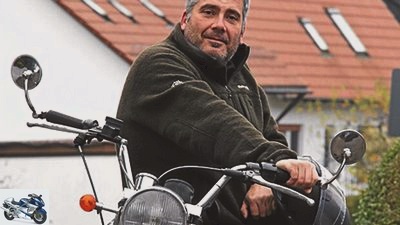
Chaqune
Moto Guzzi driver Holger Siegel is the spokesman for the motorcycle noise working group in the BUND.
When was the initiative founded??
The BUND’s motorcycle noise working group has existed since 2005. We are now coordinating the local citizens’ initiatives in the United Working Groups against Motorcycle Noise (VAGM e.V.).
You are a passionate motorcyclist yourself and take action against the associated driving noises. How does that fit together??
I am not bothered by the inevitable driving noises. I am much more bothered by the deliberate loudness of the machines by manipulating the exhaust, but also by industrial tricks with exhaust flaps and the widespread accessory exhausts with EU-ABE. The motorcycle is calculated more and more quietly on paper – in practice, many copies are now many times louder. And this practice has now been transferred to quads and sports cars. In general, we don’t mind the individual either – it’s about the massing of the sounds on certain stretches. And about the often permanent ramping up and down at these points.
What are the goals of the movement?
I think it is difficult to convert the target group: We assume around a third of motorcyclists who consciously turn the volume control – legally or illegally. This third consciously or unconsciously accepts the nuisance of residents on popular motorcycle routes and hotspots. In the VAGM we exchange information and develop options for action together. We’re collecting money for legal action. There is little or no help from the authorities against the noise.
Has the campaign made a difference??
If you act as an individual or as a local citizens’ initiative because you can no longer find peace in your house or on your property in summer, you need staying power. They are usually ironed out by the authorities: There is nothing you can do about that anyway. We talk to politicians and the media in a network and sharpen our arguments. We can at least show how complicated the situation is at the moment and that there is an urgent need for action. Police experts complain that at the moment all the dams of acoustic decency are breaking with new motorcycle models.
How do the bikers react to the initiative??
There are two different reactions: Some recognize that more and more beautiful stretches are being closed because accidents often come along with the noise. Above all, these are the inconspicuous drivers of touring bikes who are less noisy. This group at least shows understanding. The others, especially sports and Harley riders, already deny the problem – even though it originates from them.
What is your message to the motorcyclists?
Motorcycling can be done without bothering others and is still fun. A low-noise driving style is also usually less risky – this also reduces the risk of falling victim to an accident.
Related articles
-
Manufacturer statements on the subject of motorcycle noise
Motorcycle noise Debate about the volume of motorcycles Astrid Gast – stock.adobe.com counselor traffic & business Manufacturer statements on the subject…
-
Against loud motorcycles: Paris starts noise brigade
Motorcycle noise Debate about the volume of motorcycles Akrapovic counselor traffic & business Against loud motorcycles: Paris starts noise brigade…
-
new regulation for driving school motorcycles from 2019
jkuenstle.de counselor traffic & business new regulation for driving school motorcycles from 2019 Driving license class A From 2019 larger motorcycles…
-
MOTORRAD Podcast Curve Discussion Episode 10: Sound or Noise?
Motorcycle noise Debate about the volume of motorcycles Kesstech counselor traffic & business MOTORRAD Podcast Curve Discussion Episode 10: Sound or…
-
Noise driving ban in Austria: Legal series motorcycles also affected
Motorcycle noise Debate about the volume of motorcycles Manufacturer, Markus Jahn, Arturo Rivas, moonrun (fotolia) counselor traffic & business Noise…
-
Tops and Flops – Used Motorcycles 2016
markus-jahn.com, r-photography.info, jkuenstle.de, MOTORRAD-Archiv, Herzog, bilski-fotografie.de, fact.de 19th pictures jkuenstle.de 1/19 Second-hand…
-
Euro 5 for motorcycles from 2020
Katrin Sdun counselor traffic & business Euro 5 for motorcycles from 2020 Euro 5 for motorcycles from 2020 First exhaust gas values, then OBD II and…
-
Sound experience on motorcycles
motorcycles Sound experience on motorcycles Sound experience on motorcycles The ear goes with you Motorcycling as a sensual event starts at the top. And…
-
Motorcycle noise initiative in B-W and interview with Minister of Transport
Motorcycle noise Debate about the volume of motorcycles Baden-Wurttemberg Ministry of Transport counselor traffic & business Motorcycle noise initiative…
-
Noise driving ban: Greens demand noise barriers like in Tyrol
Motorcycle noise Debate about the volume of motorcycles Michael Schumann counselor traffic & business Noise driving ban: Greens demand noise barriers…